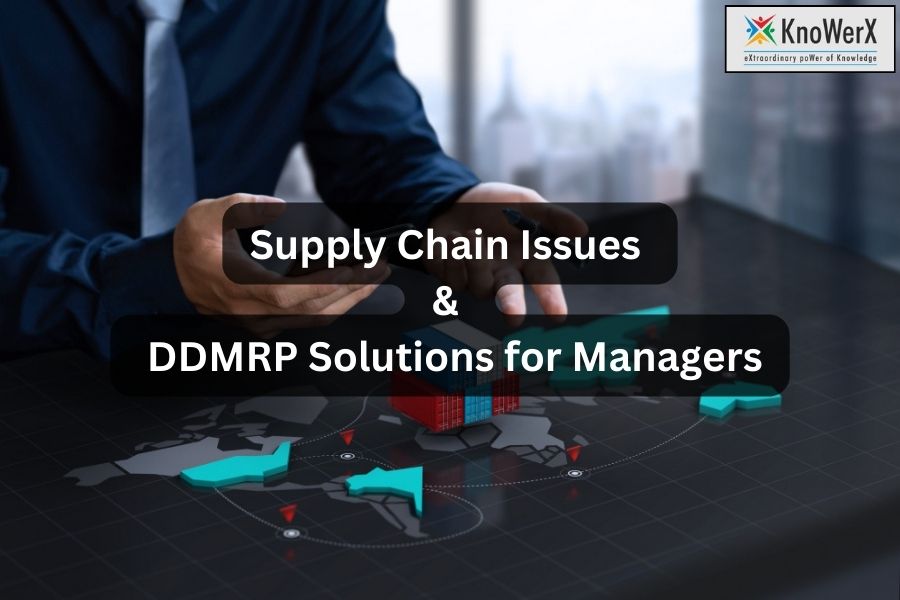5 Supply Chain Issues & DDMRP Solutions for Managers

5 Supply Chain Issues & DDMRP Solutions for Managers Supply chain management has become increasingly complex in today’s fast-paced, unpredictable business environment. Supply chain managers are grappling with a host of challenges that impact efficiency, profitability, and customer satisfaction. From high inventory holding costs to difficulty responding to changing demand, these issues require innovative solutions. Enter DDMRP (Demand-Driven Material Requirements Planning) and the Demand-Driven Planner Professional (DDPP) programme, which offer a modern approach to tackling these challenges. In this blog, we’ll explore the top five challenges supply chain managers face and how DDMRP, as one of the most effective supply chain solutions, can help address them. By leveraging DDMRP, businesses can enhance visibility, improve responsiveness, and optimize inventory levels, making it a game-changer in the world of supply chain management. 1. High Inventory Holding Costs One of the most persistent challenges for supply chain managers is balancing inventory levels to avoid excessive holding costs. Traditional MRP systems often lead to overstocking due to their reliance on forecasts and assumptions of stable demand. This results in higher storage costs, increased risk of obsolescence, and tied-up capital. How DDMRP Helps Inventory Holding Costs DDMRP introduces a demand-driven approach that focuses on actual demand rather than forecasts, offering innovative supply chain solutions. By strategically positioning buffers and dynamically adjusting inventory levels, DDMRP reduces excess stock while ensuring availability. This leads to lower holding costs and improved cash flow, making it a game-changer for inventory management and a key component of modern supply chain solutions. 2. Stockouts and Lost Sales Stockouts are a nightmare for supply chain managers, leading to lost sales, dissatisfied customers, and damaged brand reputation. Traditional MRP systems often fail to account for demand variability, resulting in inadequate stock levels during peak demand periods. How DDMRP Helps Stockouts and Lost Sales DDMRP uses decoupling points and buffer zones to ensure that critical inventory is always available, making it one of the most effective supply chain solutions for modern businesses. By responding to real-time demand signals, DDMRP minimizes the risk of stockouts and ensures that customers receive their orders on time. This not only boosts sales but also enhances customer loyalty, showcasing the power of advanced supply chain solutions in driving operational efficiency and customer satisfaction. 3. Inefficient Processes Many supply chain processes are plagued by inefficiencies, from redundant workflows to poor coordination between departments. These inefficiencies lead to delays, increased costs, and reduced productivity. How DDMRP Helps in Inefficient Processes DDMRP streamlines supply chain processes by integrating planning and execution. Its focus on real-time data and collaboration eliminates silos and improves communication across the supply chain. This results in faster decision-making, reduced lead times, and overall operational efficiency. 4. Lack of Visibility and Control A lack of visibility into supply chain operations is a major pain point for managers. Without real-time insights, it’s difficult to identify bottlenecks, track inventory, or respond to disruptions effectively. How DDMRP Helps on Visibility and Control DDMRP provides enhanced visibility through its dynamic buffer management system, making it one of the most effective supply chain solutions available. Managers can monitor inventory levels, demand patterns, and supply chain performance in real time. This increased transparency enables better control over operations and quicker responses to unforeseen challenges, further solidifying DDMRP as a leading approach among modern supply chain solutions. 5. Difficulty Responding to Changing Demand In today’s volatile markets, demand can shift rapidly due to factors like seasonality, economic changes, or competitor actions. Traditional MRP systems, which rely on static forecasts, struggle to adapt to these fluctuations. How DDMRP Helps in Difficulty Responding DDMRP is designed to handle variability and uncertainty. By using actual demand data and adjusting buffers dynamically, DDMRP enables supply chains to respond swiftly to changing conditions. This agility ensures that businesses can meet customer demands without overstocking or understocking. The Role of the Demand-Driven Planner Professional (DDPP) Programme To effectively implement DDMRP, supply chain professionals need the right skills and knowledge. This is where the Demand-Driven Planner Professional (DDPP) programme comes in. Recognized by Gartner as one of the top 10 supply chain planning programmes globally, the DDPP certification equips professionals with the expertise to lead DDMRP implementation and drive supply chain transformation. The programme focuses on: Understanding the principles of DDMRP. Enhancing planning and execution strategies. Transitioning from traditional MRP systems to demand-driven models. By earning the DDPP certification, professionals can help their organizations reduce inventory costs, improve service levels, and achieve greater supply chain resilience. Ending Notes At KnoWerX – An Institute of Supply Chain Management, we understand the challenges supply chain managers face in today’s dynamic environment. That’s why we emphasize the importance of innovative approaches like DDMRP and support professionals in gaining the skills needed to excel. The Demand-Driven Planner Professional (DDPP) programme is a cornerstone of our curriculum, designed to prepare supply chain leaders for the future. By embracing DDMRP and earning the DDPP certification, professionals can overcome the top challenges in supply chain management and drive meaningful change within their organizations. As the supply chain landscape continues to evolve, KnoWerX remains committed to equipping professionals with the tools, knowledge, and supply chain solutions they need to stay ahead. Together, we can build agile, efficient, and resilient supply chains that thrive in the face of uncertainty. Key Takeaways High Inventory Holding Costs Traditional MRP systems often lead to overstocking and increased holding costs. DDMRP Solution: By focusing on actual demand and dynamically adjusting inventory buffers, DDMRP reduces excess stock and lowers holding costs. Stockouts and Lost Sales Stockouts result in lost sales and unhappy customers. DDMRP Solution: Strategic buffer zones and real-time demand signals ensure critical inventory is always available, minimizing stockouts and boosting customer satisfaction. Inefficient Processes Redundant workflows and poor coordination lead to delays and higher costs. DDMRP Solution: DDMRP integrates planning and execution, streamlining processes and improving collaboration across the supply chain. Lack of Visibility and Control Limited visibility into operations makes it hard to track inventory or respond to disruptions. DDMRP Solution: Real-time buffer management provides enhanced visibility, enabling better control and quicker responses to challenges. Difficulty Responding to
